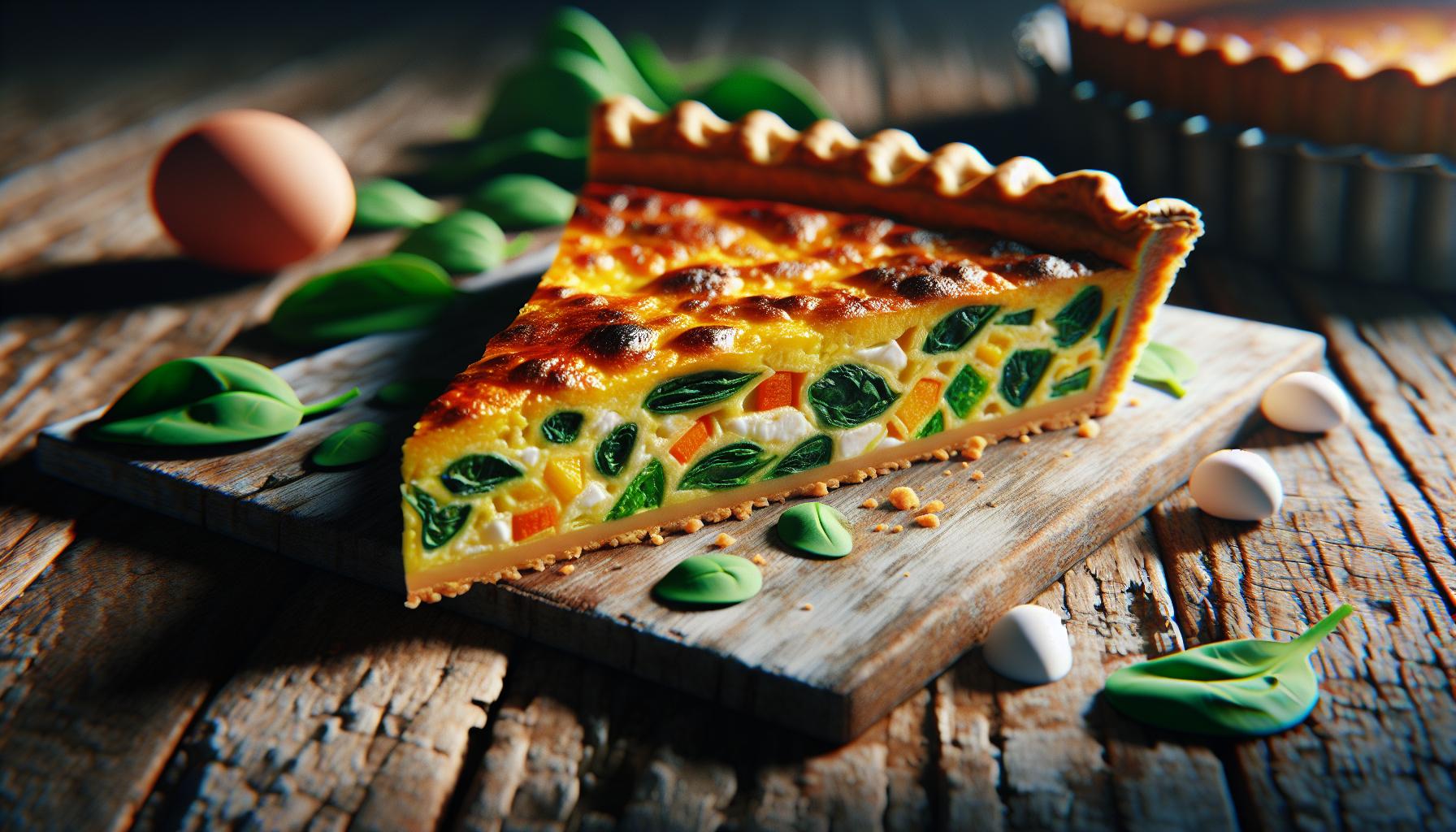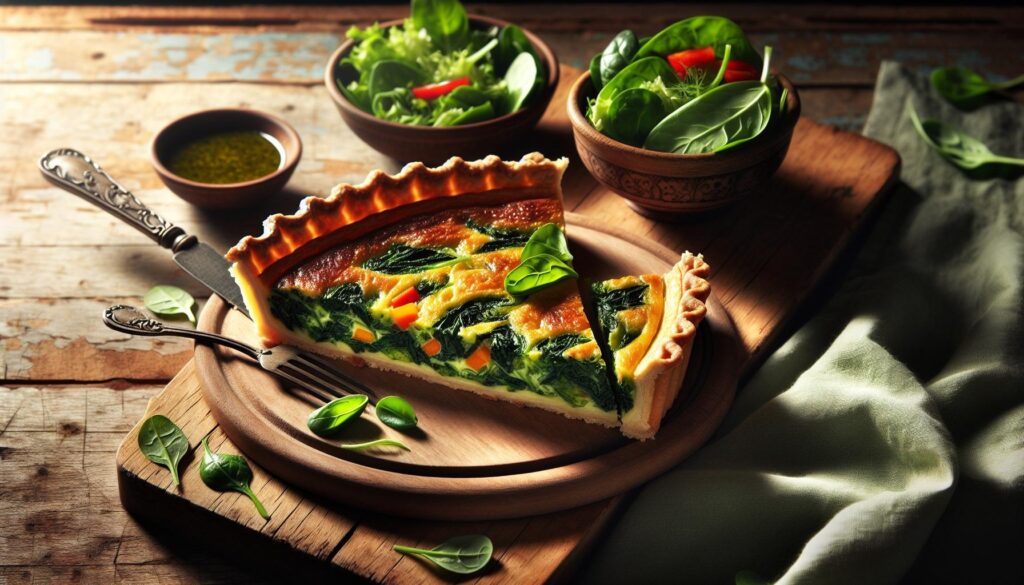Quiche lovers rejoice! This savory French pie isn’t just a delicious brunch staple – it’s also packed with essential nutrients that can contribute to a well-balanced diet. From protein-rich eggs to calcium-loaded cheese and nutrient-dense vegetables this versatile dish offers more than just incredible taste.
Whether you’re a health-conscious foodie or simply curious about what’s really in your favorite breakfast pie understanding quiche nutrition can help make informed dietary choices. While traditional recipes might pack a caloric punch modern variations can transform this classic dish into a nutritious powerhouse that fits various dietary needs and lifestyle goals. Let’s slice into the nutritional facts and discover why this beloved dish deserves a spot in your healthy meal rotation.
Quiche Nutrition
A traditional quiche combines a flaky pastry crust filled with a savory custard mixture. The fundamental components create a versatile dish that accommodates various ingredients and dietary preferences.
Basic Ingredients and Their Nutritional Value
The core ingredients of quiche deliver essential nutrients for a balanced meal. Eggs form the protein-rich base, providing 6 grams of complete protein per large egg along with vitamin D, B12, selenium. Heavy cream contributes healthy fats and creates the custard’s silky texture while adding vitamins A E. The pastry crust, made from flour butter, supplies complex carbohydrates energy. Here’s the nutritional breakdown per 100g of basic quiche mixture:
| Nutrient | Amount |
|---|---|
| Calories | 310 |
| Protein | 13g |
| Fat | 22g |
| Carbohydrates | 15g |
| Calcium | 180mg |
Common Add-ins and Their Health Benefits
Popular quiche additions enhance both flavor nutrition. Spinach introduces iron folate fiber while mushrooms add vitamin D selenium. Bell peppers contribute vitamin C antioxidants. Swiss cheese delivers calcium protein phosphorus. Lean proteins like ham turkey bacon boost the protein content further. Common nutritious mix-ins include:
- Leafy greens: kale spinach Swiss chard
- Vegetables: broccoli asparagus tomatoes
- Proteins: salmon chicken turkey
- Dairy: goat cheese feta Gruyere
- Herbs: fresh basil thyme chives
Each ingredient adds unique nutritional benefits while maintaining the classic quiche profile.
Caloric and Macronutrient Content

A standard 100g serving of traditional quiche contains 310 calories with a balanced distribution of macronutrients. The nutritional composition varies based on ingredients chosen for the filling.
Protein Content
A classic quiche delivers 13g of protein per 100g serving. Eggs serve as the primary protein source, providing all nine essential amino acids. Additional protein comes from cheese (4-6g per serving) dairy components (2-3g per serving) in the custard base. Common protein-rich add-ins include:
- Ham adds 15-18g protein per cup
- Bacon contributes 11-13g protein per cup
- Spinach provides 3g protein per cup
- Swiss cheese adds 8g protein per cup
- Mushrooms contain 2-3g protein per cup
Fat and Cholesterol Levels
The fat content in quiche averages 22g per 100g serving, primarily from:
| Fat Source | Amount per 100g |
|---|---|
| Saturated Fat | 12g |
| Monounsaturated Fat | 7g |
| Polyunsaturated Fat | 3g |
| Cholesterol | 165mg |
The butter-based crust contributes 30% of the total fat content. Heavy cream adds 15-20% while cheese accounts for 25-30% of the total fat.
Carbohydrate Breakdown
A traditional quiche contains 15g of carbohydrates per 100g serving. The pastry crust represents the main carbohydrate source with:
- Complex carbs: 8-10g
- Dietary fiber: 0.8-1.2g
- Simple sugars: 2-3g
- Onions: +3g per 1/2 cup
- Bell peppers: +2g per 1/2 cup
- Broccoli: +3g per 1/2 cup
- Mushrooms: +1g per 1/2 cup
Key Vitamins and Minerals in Quiche

Quiche delivers an array of essential vitamins and minerals through its combination of dairy products, eggs and vegetables. The nutrient profile varies based on specific ingredients, with traditional recipes offering substantial amounts of key micronutrients.
Calcium and Vitamin D
A standard slice of quiche contains 180mg of calcium, primarily from cheese and dairy ingredients. The calcium content increases to 250mg per serving when made with calcium-rich cheeses like Gruyere or Swiss. Vitamin D appears in significant amounts through egg yolks (40 IU per egg) and fortified dairy products used in the custard filling. The combination of calcium and vitamin D supports optimal nutrient absorption, as vitamin D aids calcium utilization in the body. Heavy cream adds 100mg of calcium per 100ml while contributing additional vitamin D through fortification.
B-Complex Vitamins
Eggs in quiche provide substantial B-complex vitamins, including B12 (0.6mcg per egg) and riboflavin (0.2mg per egg). The cheese filling contributes additional B12, with aged cheeses offering up to 0.9mcg per ounce. Spinach and other leafy greens commonly added to quiche contain folate (100mcg per cup of cooked spinach). Mushrooms enhance the B vitamin content by adding niacin (3.5mg per cup) and pantothenic acid (1.5mg per cup). The combination of these ingredients creates a rich source of B vitamins that support energy metabolism and nervous system function.
Making Quiche More Nutritious

A traditional quiche transforms into a healthier dish through strategic ingredient substitutions. Modern adaptations reduce calories while maintaining the classic quiche texture and taste.
Healthy Crust Alternatives
Nutritious crusts enhance quiche’s health benefits through alternative ingredients. Almond flour creates a protein-rich base with 21g protein per cup. Whole wheat pastry offers 16g of fiber per cup while maintaining flakiness. Cauliflower creates a low-carb option with only 5g net carbs per serving. Additional crust options include:
- Ground nuts mixed with eggs for a protein-focused base
- Quinoa pressed into shape for added protein and minerals
- Sweet potato slices layered for vitamin A and fiber
- Rolled oats combined with ground flaxseed for omega-3s
- Plant-based milk alternatives reducing saturated fat
- Cottage cheese adding 28g protein per cup
- Fresh herbs increasing antioxidant content
- Reduced-fat cheese maintaining calcium levels
- Extra vegetables boosting fiber and micronutrients
Special Dietary Considerations
Quiche adapts easily to various dietary requirements through ingredient modifications. Modern recipe variations accommodate specific nutritional needs while maintaining the classic taste profile.
Gluten-Free Options
Gluten-free quiche starts with alternative flour blends for the crust. Almond flour creates a nutty-flavored base with 6g of protein per serving. Rice flour combined with tapioca starch produces a light crispy texture. Certified gluten-free oat flour offers 4g of fiber per serving. Pre-made gluten-free crusts save preparation time while ensuring safety for celiac individuals. The filling remains naturally gluten-free when using pure ingredients like eggs, cream, cheese, vegetables. Cross-contamination prevention requires separate preparation surfaces, utensils.
Low-Carb Adaptations
A crustless quiche eliminates 15g of carbohydrates per serving. Cauliflower rice pressed into a pie dish creates a 4g net carb crust alternative. Almond flour mixed with parmesan cheese produces a keto-friendly base containing 2g net carbs per serving. Heavy cream substitutes include unsweetened almond milk with 0g carbs per cup. Low-carb vegetables like spinach, mushrooms, bell peppers add nutrients without significant carbohydrates. Cheese varieties such as cheddar, gruyere contain minimal carbs while providing protein, calcium. Net carbs in a low-carb quiche average 5-7g per serving compared to 15-20g in traditional recipes.

